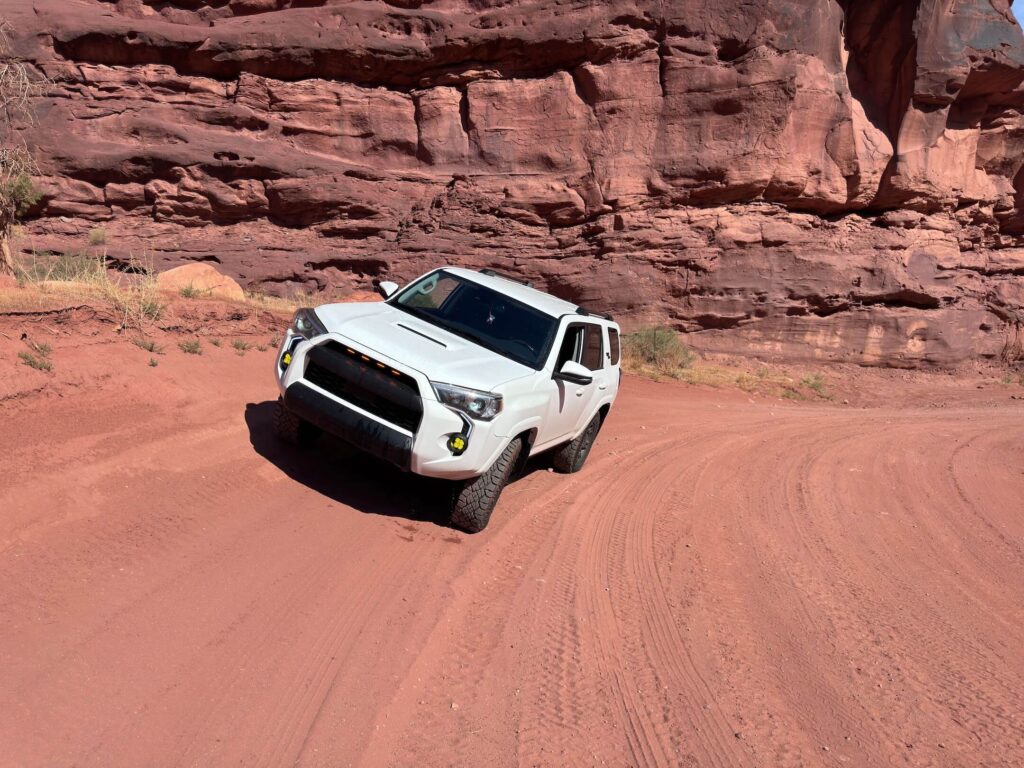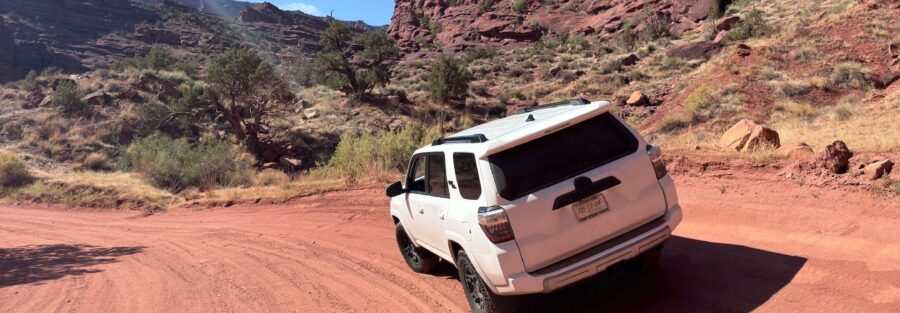Quick Facts:
Location: Moab, Utah
Coordinates: 38.72052133611222, -109.34353916196686
Length: 20 Miles (Out and Back)
Difficulty: Easy
Elevation Gain: 2,000 Feet
Discovering Onion Creek Trail: An Off-Roading Gem Near Moab, Utah
Just outside Moab, Utah, Onion Creek Trail is a favorite for off-roaders drawn to its red rock canyons, fun creek crossings, and dramatic rock formations. This scenic route winds through Onion Creek Canyon, surrounded by towering cliffs and vibrant, multicolored rock formations that create a surreal desert landscape. Known for its manageable terrain and epic photo spots, Onion Creek Trail is the perfect mix of adventure and jaw dropping scenery, ideal for both beginners and experienced off-roaders.
How to Get There
Getting to Onion Creek Trail is simple and scenic. Head north on US-191 from Moab, then turn onto UT-128, also known as the Upper Colorado River Scenic Byway. After about 20 miles, you’ll see a marked turnoff for Onion Creek Road, where the dirt trail begins. The road is accessible for most vehicles, but a high-clearance 4×4 is best if you want to tackle the creek crossings and rougher sections. It’s a straightforward drive, and the red rock views along the way are worth the trip alone!
The Landscape: What to Expect
Once you’re on the trail, you’ll be surrounded by classic Utah scenery, deep red rock, sheer canyon walls, and a winding creek that you’ll cross multiple times. The trail hugs Onion Creek as it carves through the canyon, and you’ll hit over 20 shallow creek crossings along the way, making for a fun and sometimes splashy drive. One of the most striking parts of Onion Creek Trail is the colorful rock layers, with reds, oranges, purples, and greens showing off Utah’s unique geology. Along the way, keep an eye out for natural arches, hoodoos, and rocky towers that make this trail a dream for photographers.
Trail Difficulty and Length
Onion Creek Trail stretches about 10 miles one way, giving you roughly 20 miles of round trip adventure. The terrain is mostly moderate, with creek crossings and some rocky patches that keep things interesting without being too technical. The trail’s fun, scenic, and manageable for all skill levels, making it a hit with beginners and experienced drivers alike.

Local Guidelines and Helpful Tips
To help keep Onion Creek Trail beautiful and accessible, there are a few local guidelines to follow. Always stay on designated trails to avoid damaging plants and rocks, and pack out all trash as part of the Leave No Trace principles. Keep noise to a minimum near water sources, as Onion Creek is a key water supply for local wildlife. Pets are welcome but should be leashed, and fire restrictions may apply in dry months, be sure to check before you go. And if it’s flash flood season, be cautious of rain in the forecast, as water levels in the creek can rise quickly and make crossings risky.
Other Trails Nearby
Moab is an off-roader’s paradise, with plenty of nearby trails to explore. Just a short drive from Onion Creek is the Fisher Towers Trail, a scenic hiking route with towering rock formations and amazing overlooks. If you’re up for more off-roading, Dome Plateau offers cliffside views, scenic vistas, and cool geological landmarks for a bit more challenging ride. For those after a real thrill, check out Moab’s famous Hell’s Revenge and Fins & Things trails, which offer exciting, technical terrain for seasoned drivers.
Non-Off-Road Attractions Around Moab
Moab is full of things to do beyond the trails. Arches National Park, just outside Moab, is a must-see for its stunning rock arches and scenic drives. Nearby, the Colorado River has spots for rafting, paddle-boarding, and relaxing river cruises. For a bit of history, stop by the Moab Museum to learn about the area’s geology, history, and Native American heritage. Downtown Moab has a vibrant atmosphere with lots of local restaurants, art galleries, and shops, a great place to unwind after a day of adventure.
Accommodations: Where To Set Up Basecamp
Hoodoo Moab, Curio Collection by Hilton
Hoodoo Moab feels like a desert oasis after a long day of red rock adventures. The design blends rustic Southwest character with modern luxury, and the pool area is one of the best in town for cooling off after hiking in Arches or Canyonlands. You’ll get spacious rooms, excellent on-site dining, and a location that keeps you within walking distance of shops and restaurants on Main Street.
👉 Book your stay at Hoodoo Moab here for exclusive rates and perks.
Element Moab is all about comfort and functionality with a clean, eco-friendly vibe. The rooms come with kitchenettes, perfect for travelers who want to fuel up on their own schedule. The complimentary breakfast is a huge plus before hitting the trails, and the hotel’s location gives you quick access to Arches National Park. Add in the saltwater pool and firepit area, and it’s a fantastic base for both families and solo adventurers.
👉 Reserve your stay at Element Moab here and save while supporting Unicorn Adventure.
Best Time to Visit
The best times to hit Onion Creek Trail are spring and fall (April to May and September to October) when temperatures are mild, making the whole experience much more comfortable. Spring even brings wildflowers in bloom, adding more color to the already stunning landscape. Fall offers cooler temps and fewer crowds, ideal for those seeking a quieter trail. Summer can be scorching, often hitting 100°F, which can make creek crossings a bit less fun. Flash floods are more common in summer, so always check the weather before heading out.
Support the Adventure
To make your walls less boring, check out my photography portfolio and bring a piece of the wild and my story into your home.
If you’d like to fuel future adventures, you can donate a coffee on Ko-Fi. Every cup keeps me chasing sunrises and stories.
When you shop using my affiliate links, every click helps support this blog at no extra cost to you. It’s a small way to keep Unicorn Adventure alive and kicking while I keep exploring.
Subscribe to my mailing list for future updates, new stories, and behind-the-scenes adventures.
Stay connected with me on Instagram and Facebook for more photos and daily inspiration.
Thanks for being part of the journey, Unicorn Squadron!


